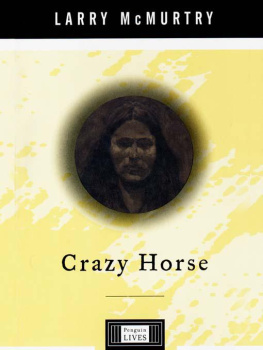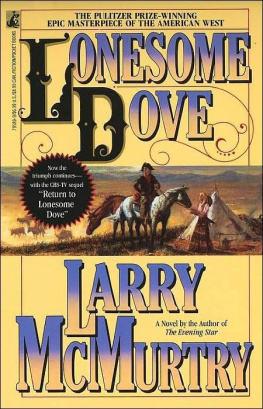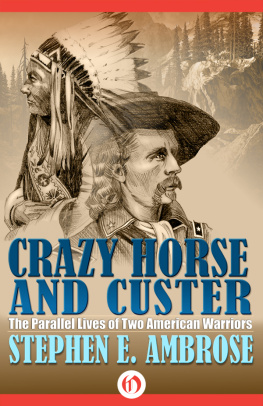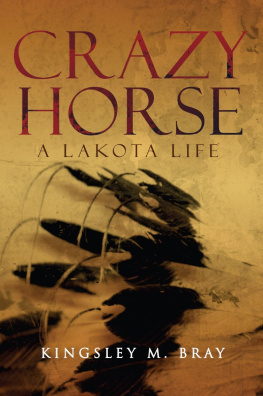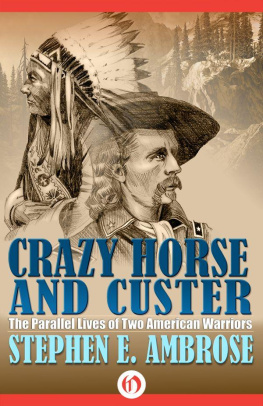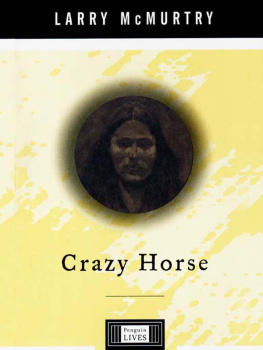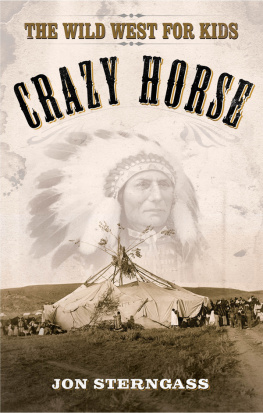PENGUIN BOOKS
Published by the Penguin Group
Penguin Books USA Inc., 375 Hudson Street,
New York, New York 10014, U.S.A.
Penguin Books Ltd, 27 Wrights Lane,
London W8 5TZ, England
Penguin Books Australia Ltd, Ringwood,
Victoria, Australia
Penguin Books Canada Ltd, 10 Alcorn Avenue, Toronto, Ontario, Canada M4V 3B2
Penguin Books (N.Z.) Ltd, 182-190 Wairau Road, Auckland 10, New Zealand
Penguin India, 210 Chiranjiv Tower, 43 Nehru Place, New Delhi 11009, India
Penguin Books Ltd, Registered Offices:
Harmondsworth, Middlesex, England
First published in 1999 by Viking Penguin, a member of Penguin Putnam Inc.
Copyright Larry McMurtry, 1999
All rights reserved
McMurtry, Larry.
Crazy Horse / Larry McMurtry.
p. cm.
A Penguin Life.
ISBN 0-7865-0294-0
First edition (electronic): August 2001
Making or distributing electronic copies of this book constitutes copyright infringement and could subject the infringer to criminal and civil liability.
ALSO IN THE PENGUIN LIVES SERIES
Edmund White on Marcel Proust
Jane Smiley on Charles Dickens
Garry Wills on Saint Augustine
Carol Shields on Jane Austen
Peter Gay on Wolfgang Amadeus Mozart
Mary Gordon on Joan of Arc
Karen Armstrong on the Buddha
Jonathan Spence on Mao Zedong
Patricia Bosworth on Marlon Brando
Edna OBrien on James Joyce
R. W. B. Lewis on Dante
Janet Malcolm on Anton Chekhov
Marshall Frady on Martin Luther King, Jr.
Paul Johnson on Andrew Carnegie
GENERAL EDITOR: JAMES ATLAS
For Leslie Marmon Silko
C RAZY H ORSE , a Sioux warrior dead more than one hundred and twenty years, buried no one knows where, is rising again over Pa Sapa, the Black Hills of South Dakota, holy to the Sioux. Today, as in life, his horse is with him. Fifty years of effort on the part of the sculptor Korczak Ziolkowski and his wife and children have just begun to nudge the man and his horse out of what was once Thunderhead Mountain. In the half-century that the Ziolkowski family has worked, millions of tons of rock have been moved, as they attempt to create what will be the worlds largest sculpture; but the man that is emerging from stone and dirt is as yet only a suggestion, a shape, which those who journey to Custer, South Dakota, to see must complete in their own imaginations.
It is a nice irony that the little town Crazy Horse has come to brood over is named for his old adversary George Armstrong CusterLong Hair, whose hair, however, had been cut short on the day of his last battle, so that it is not certain that the Sioux or Cheyenne who killed him really recognized him until after he was dead. Crazy Horse had one good look at Custer, in a skirmish on the Yellowstone River in 1873, but Custer probably never saw Crazy Horse clearly enough to have identified him, either on the Yellowstone or at the Little Bighorn, three years later. The thousands who come to the Crazy Horse Monument each year see him as yet only vaguely; but that, too, will change. One day his arm will stretch out almost the length of a football field; statistics will accumulate around his mountain just as legends, rumors, true tales and tall tales, accumulated around the living man.
What should be stressed at the outset is that Crazy Horse was loved and valued by his people as much for his charity as for his courage. Ian Frazier, in his fine book Great Plains, reports correctly that the Crazy Horse Monument is one of the few places on the Great Plains where one will see a lot of Indians smiling. The knowledge of his charity is still a balm to his people, the Sioux people, most of whom are poor and all of whom are oppressed. Peter Matthiessen was right to call his bitterly trenchant report on the troubles the Pine Ridge Sioux had with the U.S. government in the 1970s In the Spirit of Crazy Horse, because the spirit of Crazy Horse was a spirit unbroken, though it was certainly raked raw by the difficulties of his last few months.
George E. Hyde, the great (if cranky) historian of the Oglala and the Brul Sioux, a man not easily swept off his feet by even the most potent myth, confessed his puzzlement with the Crazy Horse legend in words that are neither unfair nor inaccurate: They depict Crazy Horse as a kind of being never seen on earth: a genius at war yet a lover of peace; a statesman who apparently never thought of the interest of any human being outside his own camp; a dreamer, a mystic, and a kind of Sioux Christ, who was betrayed in the end by his own disciplesLittle Big Man, Touch-the-Clouds and the rest. One is inclined to ask, what is it all about?
A Sioux Christ? That touches on his charity and on his betrayal, but he was a determined warrior too, one of the great Resisters, men who do not compromise, do not negotiate, do not administer, who exist in a realm beyond the give-and-take of conventional politics and who stumble and are defeated only when hard circumstances force them to live in that realm.
I saw the Crazy Horse Monument one day while traveling north to visit the grave of that sad, boastful woman Martha Jane Canary (Calamity Jane), who lies in the Deadwood cemetery next to James Butler Hickok (Wild Bill), a proximity he could not protest, since Calamity outlived him by a quarter of a century. I was easing through the Black Hills buffalo herdmany of the buffalo stood in the road, dull and incurious, as indifferent to the traffic as they had been to the buffalo hunters who slaughtered some fifty million of them in a short space of time in the last centurywhen I slowly became aware of something: something large. I looked up and saw the Crazy Horse mountain, just to the northeast. Great hundred-yard swirls of white paint streaked the mountain, representing his hair; below him more swirls of the same white paint formed a Picassoesque horse head.
Like most travelers who come unexpectedly onto the monument, I was stunned, too stunned even to go up to the gift shop. I stopped the car, sat on the hood, and looked, as buffalo ambled by. What loomed above me, framed by the blue Dakota sky, was an American Sphinx. He was there, but as a force, an indefiniteness, a form made more powerful by his very abstractness.
I suppose, someday, the Ziolkowski family will finish this statue. It may take another generation or two, and when its finished, if Im alive, Id like to see it. But Im glad that I saw the mountain in the years when Crazy Horse was still only a form and a mystery. Now that Ive read what there is to read about him, I think this indefiniteness was also an aspect of the man. His own people experienced him as a mystery while he was alive: they called him Our Strange Man. In his life he would have three names: Curly, His Horses Looking, Crazy Horse (Ta-Shunka-Witco). We know him as Crazy Horse, but in life few knew him well; in truth it is only in a certain limited way that we who are living now can know him at all. George Hyde, who resisted his legend, knew that in spite of what he himself wrote, time had already separated the myth from the man, obliterating fact. Fair or not, that is the way with heroes: Geronimo, Crazy Horse, Sitting Bull, Billy the Kid, Custer. For all such men, fact withers in the heat of myth. George Hyde felt the frustrations all historians feel when they find a legend blocking their route to what had once only been a man.
Crazy Horses legend grew in the main from a broken peoples need to remember and believe in unbroken heroes, those who remained true to the precepts of their fathers and to the ways of the culture and the traditions which bred them.
Certainly the whites who fought Crazy Horse helped build his legend, too. Agent Jesse Lee, who brought Crazy Horse back from the Spotted Tail agency to Fort Robinson, only to see him killed before he could be given the hearing that had been promised him, confessed that he was tortured by his involvement in such a dark deed. Even the stern General Crook, who, had he caught him alive, would have sent Crazy Horse off to a prison in the Dry Tortugasall on the basis of a lielater expressed regret that he had failed to sit in council with him on the last occasion that presented itself. I ought to have gone to that council, Crook said. I never start any place but that I get there.
Next page
